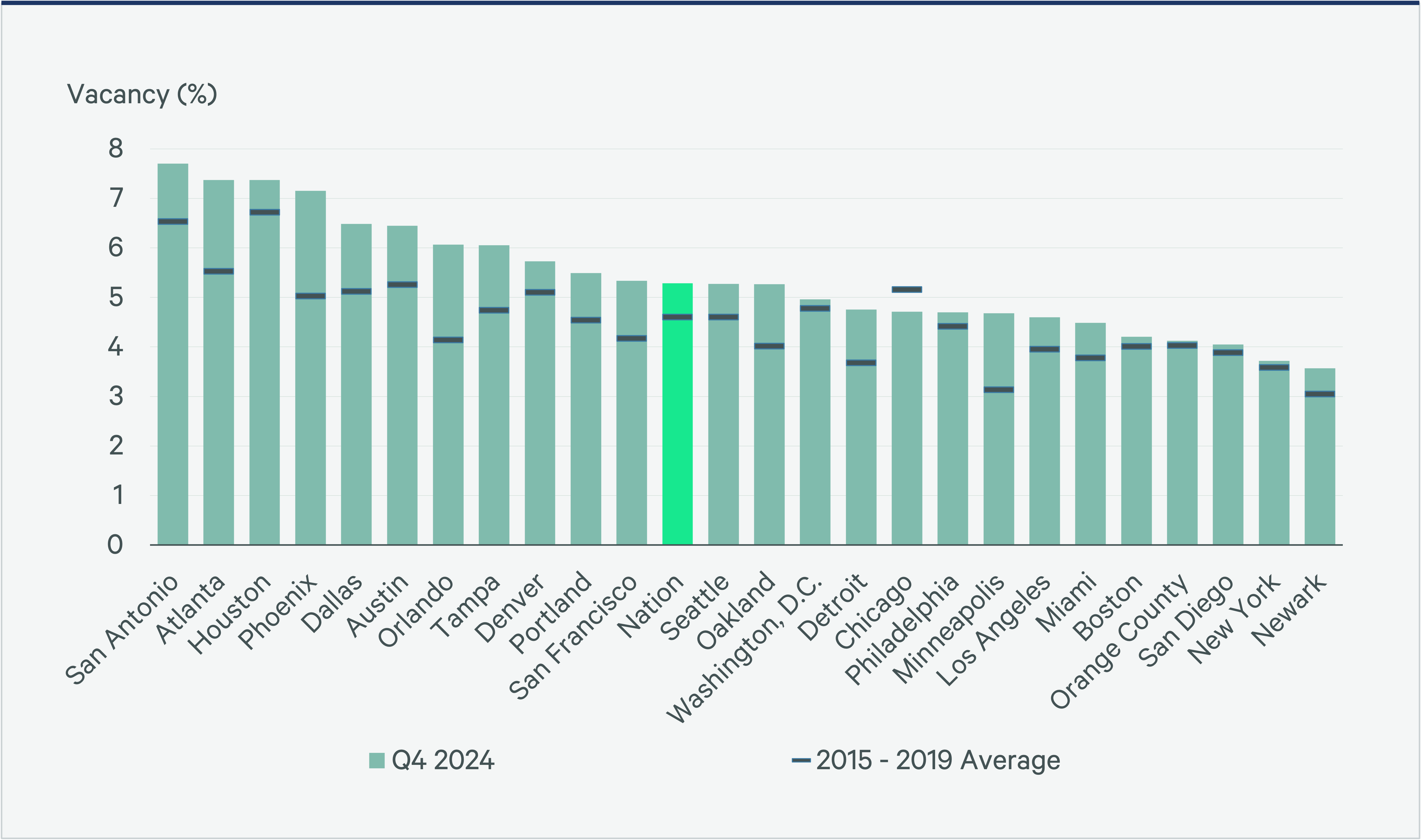Chapter 7
Multifamily
U.S. Real Estate Market Outlook 2024
5 Minute Read
Slight Apartment Oversupply Expected in 2024
The biggest wave of new apartment supply in decades will temper rent growth and improve affordability for renters in 2024. With delivery of 440,000 new units expected in 2024 and more than 900,000 currently under construction, the overall vacancy rate is expected to rise and rent growth to decelerate.
Of the 69 markets tracked by CBRE, 17 are poised to grow their inventories by more than 7% in 2024 and 2025. Construction completions have already peaked in several markets, including Chicago, Washington, D.C. and Las Vegas. Completions will peak in most other markets in 2024. We expect weaker average rent growth of 1.2% in 2024. Supply headwinds limited recent record rent growth to just 0.7% year-over-year in Q3 2023.
Despite near-term economic weakness and vacancy rates that will rise further above their pre-pandemic averages in 2024, enough demand should keep the average occupancy rate above 94%. Developers have correctly anticipated where demand will best support new supply based on job growth figures. Markets with the largest supply pipelines (e.g., Austin, Dallas, Nashville and Atlanta) have the highest job growth projections.
Figure 15: Forecast Multifamily Vacancy Rates vs. Pre-Pandemic Averages

Multifamily real estate is playing a more important role in alleviating a severe shortage (at least 3.1 million) of single-family homes that is contributing to homeownership challenges, particularly in a high-interest-rate environment. The premium for an average monthly mortgage payment of a newly purchased home vs. average monthly rent is expected to remain above 35% in 2024 versus 52% in 2023.
Multifamily construction starts are down substantially in response to overall weakening fundamentals and the rapid increase in interest rates. We expect starts will fall by 45% in 2024 from their pre-pandemic average and by 70% from their 2022 peak. This decline in starts means that new deliveries will be reduced to less than half the current level by 2026, paving the way for a strong recovery in both occupancy and rent growth.
Figure 16: Historical & Forecast Multifamily Construction Starts
In the near-term, rent growth and occupancy will remain strongest in the Midwest and Northeast regions, as well as the mature urban hubs of New York, Boston, Chicago and Washington, D.C. Many of these markets had more modest rent growth in 2021 than those in the Sun Belt and Mountain regions and have less supply pressure. Although many markets in the Mountain and Sun Belt regions are expected to continue having negative rent growth through mid-2024, this should bolster rental demand by attracting in-migration.
Many of the markets struggling with imbalanced supply and demand are expected to outperform in the long-term. Local and regional economic drivers will continue to favor large secondary markets across the Sun Belt, as well as most large coastal markets.
Investing With a Longer Time Horizon
Softer fundamentals and higher borrowing costs have negatively affected property values and created significant buying opportunities for investors. With investment activity expected to remain muted in 2024, investors have an opportunity to consider their longer-term investment strategy. A typical five-to-seven-year hold period implies they could market these assets to a buyer with a similar investment horizon.
The Midwest and Northeast regions offer the best opportunity for positive leverage in 2024. With cap rates typically 25 to 50 basis points higher than elsewhere and with stronger rent growth expected next year, buyers in these two regions can more easily underwrite to positive leverage. Cap rates are nearing their peak, so the window for favorable pricing opportunities won’t last long.
Local regulatory environments (e.g., rent control policies) and other factors like climate risks, public safety and infrastructure are becoming more important considerations for multifamily investors. Market selection and underwriting are becoming more complicated. The recent increase in both cost and availability of real estate insurance for some coastal states highlights the growing importance of these long-term factors for buyers, sellers and lenders.
Markets to Watch
- Midwest/Northeast: Supply-and-demand dynamics across the Midwest and Northeast are expected to remain balanced in 2024. This will support rent growth throughout the year, while many markets facing supply pressures will have several quarters of negative rent growth.
- San Diego: Supply growth remains muted, averaging only 3.1% over the past two years and forecast at just 2.4% in 2024. Strong demand-side fundamentals like high-quality and durable life sciences jobs will help San Diego outperform the overall market next year.
- Boston: Market fundamentals are buoyed by the growing tech and life sciences sectors, as well as a limited construction pipeline. Balanced fundamentals will support rent growth throughout 2024.
- New York City: The post-pandemic resurgence of New York’s multifamily market is expected to continue in 2024. With one of the lowest overall vacancy rates in the country, it's clear developers have struggled to keep pace with renter demand as the city continues to add jobs and residents.
- Dallas: Even as the pace of new supply lowers rent growth, Dallas has remained the biggest multifamily investment market over the past several years. Additionally, it is the largest market with the lowest average prime multifamily cap rate. These trends are expected to continue, making Dallas the most liquid market for multifamily property investment in 2024.
Related Service
- Property Type
Multifamily
Unlock the potential of your residential real estate with expert investment, financing, valuation, due diligence, design, management and leasing strat...
Related Insights
-
Average multifamily rent growth slowed to just 0.7% year-over-year in Q3, down significantly from the record 15.2% increase in Q1 2022.
-
Brief | Intelligent Investment
Higher Rates Push Up Prime Multifamily Cap Rates in Q3
October 5, 2023
Both going-in and exit cap rates for prime multifamily assets increased slightly in Q3 after the Federal Reserve’s 25-basis-point interest rate hike in July and the steady rise in the 10-year Treasury rate during the quarter.
-
Brief | Intelligent Investment
Older Multifamily Properties Achieve Above-Average Rent Growth
September 25, 2023

Investors may want to take a closer look at older multifamily properties based on a CBRE Research finding that those built before 2010 have averaged 4.6% annual rent growth over the past decade compared with 3.4% for post-2010 assets.
Insights in Your Inbox
Stay up to date on relevant trends and the latest research.

